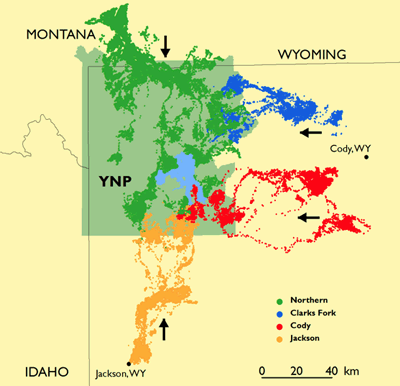Elk Migrations of the Greater Yellowstone
Project Overview
Each spring in the Greater Yellowstone Ecosystem (GYE), thousands of elk in 6-8 populations migrate from far-flung winter ranges in Wyoming, Montana, and Idaho, to high-elevation summer ranges nearer to the core of Yellowstone National Park (YNP). These migratory elk link the ecosystem’s outermost foothills to its deepest, mountain wilderness. Their abundance sustains diverse carnivores and scavengers, attracts tens of millions of dollars to gateway communities, and inspires national and global conceptions of the beloved YNP wilderness. These migrations define and unify the GYE, both ecologically and culturally.
Yet the migratory elk of the GYE are experiencing a growing number of ecological changes and conservation challenges. In addition to historical losses of winter habitat and the restoration of their primary predators – grizzly bears and wolves – some of these populations are being affected by hotter and drier summers, invasive species, and introduced disease. A combination of these factors has contributed to the decline of several herds. Currently, our understanding and management of the GYE elk migrations remains fragmentary. Scientific studies typically focus on one herd at a time; management is divided among numerous agency jurisdictions; public interest is fractured among more than 100 non-governmental organizations. Remarkably, most people in the region have never even seen a map showing the elk migrations’ striking geographic scope.
This project aims to enhance our understanding and management of these populations through a “rediscovery” of elk migration as a singular, trans-boundary phenomenon operating at the scale of the entire GYE. The primary objectives are to 1) comprehensively assess the migration routes, seasonal ranges, and population productivity of all the GYE’s migratory elk herds; 2) determine the influence of spring and summer climate on elk migration behavior at the ecosystem scale; 3) improve monitoring of migratory elk through the use of camera traps on migration bottlenecks; and 4) broaden public awareness of the migrations by developing museum-and web-based educational material and a short documentary film.
This project is led by Arthur Middleton, a postdoctoral fellow at the Yale School of Forestry and Environmental Studies, and Joe Riis, a wildlife photojournalist and contract photographer for National Geographic. Arthur has worked on the ecology of elk migration in northwest Wyoming since 2007, and Joe is building from his award-winning work to document pronghorn migration through the upper Green River Basin. In support of their work, Arthur and Joe recently won the first Camp Monaco Prize for biodiversity research and conservation in the GYE.
project funders
Project cooperators include the Wyoming Game and Fish Department, Montana Fish Wildlife and Parks, the National Park Service (Yellowstone Center for Resources), the U.S. Fish and Wildlife Service (National Elk Refuge), the U.S. Forest Service (Shoshone National Forest), the Wildlife Conservation Society, and numerous private ranches in the Greybull and South Fork of the Shoshone River valleys. Project funders include the Prince Albert II of Monaco Foundation, the Buffalo Bill Center of the West, the University of Wyoming’s Biodiversity Institute, the George B. Storer Foundation, the Knobloch Family Foundation, the Fran and Lenox Baker Foundation, the National Geographic Expeditions Council, and the Rocky Mountain Elk Foundation.

project timeline
Existing agency and university data were assembled in 2015 to produce a comprehensive map and scientific report that reveal the elk migrations and highlight key management challenges at the scale of the entire GYE. Collared migratory elk in the Cody herd were fitted with satellite collars that transmit “real-time” locations that will be used to identify migration bottlenecks where camera-trapping can be evaluated as a potential method for long-term population surveys. Photography and film footage of migrating elk were collected during the spring and fall migrations in both 2014 and 2015, with additional field work on elk summer ranges in the Thorofare of southeastern YNP. A museum photography exhibition integrating WMI cartography and real-time elk data, as well as a short film, opened in 2016.
